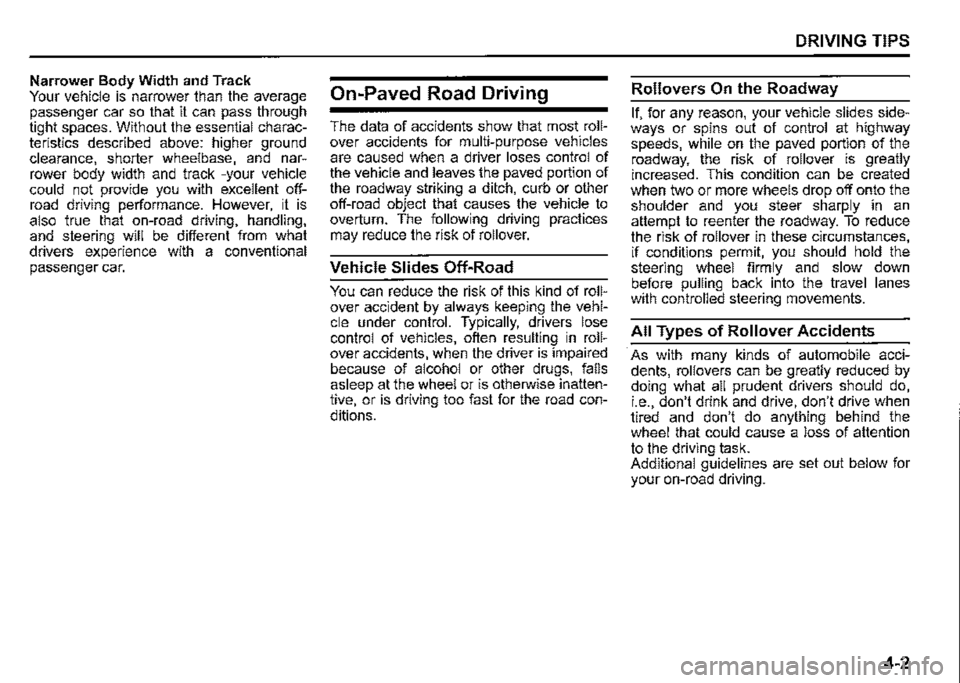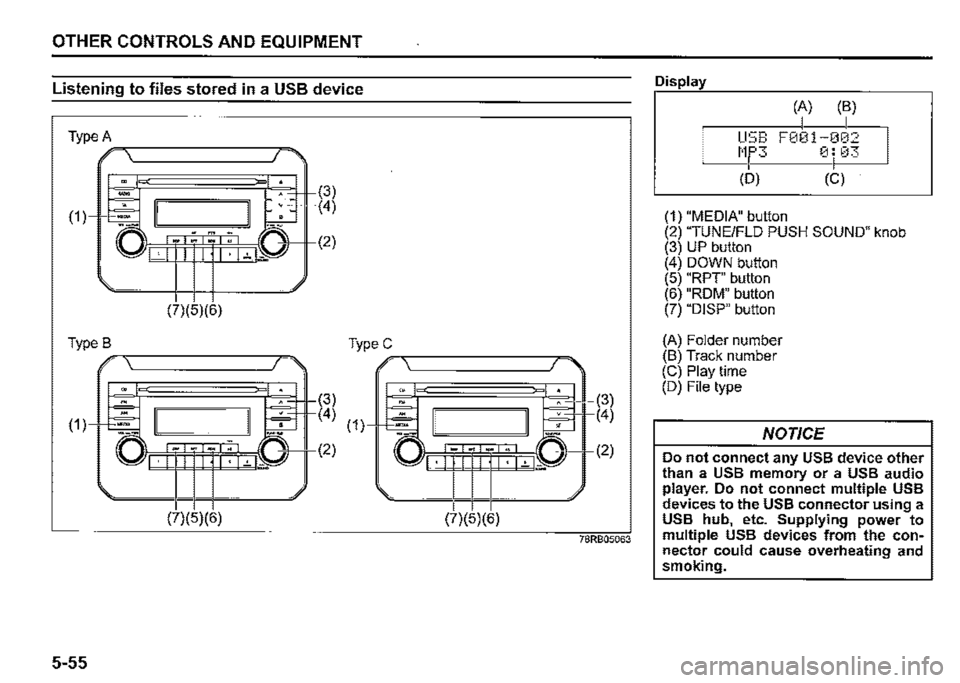Multi SUZUKI JIMNY 2021 Owners Manual
[x] Cancel search | Manufacturer: SUZUKI, Model Year: 2021, Model line: JIMNY, Model: SUZUKI JIMNY 2021Pages: 421, PDF Size: 6.35 MB
Page 224 of 421

DRIVING TIPS
52D078
A WARNING
Fasten your seat belts at all times. Even though airbags are equipped at the front seating positions, the driver and all passengers should be properly restrained at all times, using the seat belts provided. Refer to "Seat belts and child restraint systems" section for instructions on proper use of the seat belts. Never drive under the influence of alcohol or other drugs. Alcohol and drugs can seriously impair your ability to drive safely, greatly increasing the risk of injury to yourself and others. You should also avoid driving when you are tyred, sick, irritated or under stress.
4-1
Important Vehicle Design
Features to Know
A WARNING
Your multipurpose vehicle has handling characteristics that differ from those of a conventional passenger car. For the safety of you and your passengers, please read the following section very carefully.
Multipurpose vehicles such as your new SUZUKI have higher ground clearance and a narrower track than conventional passenger cars, to make them capable of performing in a wide variety of off-road applications. Specific design characteristics give them a higher center of gravity than ordinary cars. An advantage of the higher ground clearance is a better view of the road allowing you to anticipate problems. They are not designed for cornering at the same speed as conventional passenger cars any more than low-slung sports cars are designed to perform satisfactorily under off-road conditions. If at all possible, avoid sharp turns or abrupt maneuvers. As with other vehicles of this type, failure to operate this vehicle correctly may result in loss of control or vehicle rollover. Multipurpose vehicles have a significantly higher rollover rate than other types of vehicles. In a rollover collision, an
unbelted person is significantly more likely to die than a person wearing a seat belt.
Important Differences Between
Your Multipurpose Vehicle and
Ordinary Passenger Cars
Higher Ground Clearance The higher ground clearance of your vehicle enables it to clear off-road obstacles, such as rocks and tree stumps, that ordinary passenger cars cannot drive over. An unavoidable result of this higher ground clearance is that the vehicle also has a higher center of gravity. Consequently, your vehicle will handle differently than a vehicle with a lower center of gravity.
Shorter Wheelbase Along with its higher ground clearance, your vehicle has a shorter wheelbase and shorter front and rear overhangs than the typical passenger car. These features combine to allow you to drive your vehicle over hillcrests without hanging up on them or damaging the frame and chassis components. The shorter wheelbase also makes the steering of your vehicle more responsive than that of vehicles with longer wheelbases.
Page 225 of 421

Narrower Body Width and Track Your vehicle is narrower than the average passenger car so that it can pass through tight spaces. Without the essential characteristics described above: higher ground clearance, shorter wheelbase, and narrower body width and track -your vehicle could not provide you with excellent offroad driving performance. However, it is also true that on-road driving, handling, and steering will be different from what drivers experience with a conventional passenger car.
On-Paved Road Driving
The data of accidents show that most rollover accidents for multi-purpose vehicles are caused when a driver loses control of the vehicle and leaves the paved portion of the roadway striking a ditch, curb or other off-road object that causes the vehicle to overturn. The following driving practices may reduce the risk of rollover.
Vehicle Slides Off-Road
You can reduce the risk of this kind of rollover accident by always keeping the vehicle under control. Typically, drivers lose control of vehicles, often resulting in rollover accidents, when the driver is impaired because of alcohol or other drugs, falls asleep at the wheel or is otherwise inattentive, or is driving too fast for the road con
ditions.
DRIVING TIPS
Rollovers On the Roadway
If, for any reason, your vehicle slides sideways or spins out of control at highway speeds, while on the paved portion of the roadway, the risk of rollover is greatly increased. This condition can be created when two or more wheels drop off onto the shoulder and you steer sharply in an attempt to reenter the roadway. To reduce the risk of rollover in these circumstances, if conditions permit, you should hold the steering wheel firmly and slow down before pulling back into the travel lanes with controlled steering movements.
All Types of Rollover Accidents
· As with many kinds of automobile accidents, rollovers can be greatly reduced by doing what all prudent drivers should do, i.e., don't drink and drive, don't drive when tired and don't do anything behind the wheel that could cause a loss of attention to the driving task. Additional guidelines are set out below for your on-road driving.
4-2
Page 226 of 421

DRIVING TIPS
Know Your Vehicle
Take time to familiarize yourself with the unique handling characteristics of your vehicle by first driving around in an area away from traffic. Practice turning the vehicle at a variety of speeds and in different directions. Get a feel for the greater steering response that your vehicle has over a conventional car.
Wear Your Seat Belts at All Times
The driver and all passengers should be properly restrained at all times, using the seat belts provided. Refer to the "SEAT BELTS" section for instructions on proper use of the seat belts.
Don't Make Sharp Turns
As mentioned before, small multipurpose vehicles have specific design characteristics that allow them to perform in a wide variety of applications. These characteristics also change the cornering behavior relative to conventional passenger cars. Remember, small multipurpose vehicles have more responsive steering and a higher center of gravity than conventional passenger cars. If at all possible, avoid making sharp turns in your vehicle.
4-3
Slow Down on Curves
Learn to approach curves cautiously and at a conservative speed. Do not attempt to take curves at the same speeds that you would in a vehicle with a lower center of gravity. Just as you would not drive a sports car on a trail, you should not attempt to drive your vehicle around curves like a sports car.
Slow Down and Use Caution on
Slippery Roads
60G089A
Under wet road conditions you should drive at a lower speed than on dry roads due to possible slippage of tyres during braking. When driving on icy, snow-covered, or muddy roads, reduce your speed and avoid sudden acceleration, abrupt braking, or sharp steering movements. Use 4-wheel drive high range (4H) for better traction.
Page 289 of 421

Recording MP3/WMA/AAC files on a CD media It is recommended not to write both CODA files and MP3/WMA/MC files on a
disc. If both CD-DA files and MP3/WMA/MC files are on the same disc, tracks may not be played in the correct order or some tracks may not be played at all. When storing both MP3 data and WMA data on the same disc, sort and place them in different folders. Do not write files other than MP3/WMA/ MC files and unnecessary folders on a
disc. MP3/WMA/MC files should be named to meet the standards and the file system specifications as shown below. The file extension ".mp3", ".wma" or ".m4a" should be assigned to files based on their format independently. You may encounter a trouble in playing MP3/WMA/MC files or displaying information of MP3/WMA/MC files depending on the writing software or CD recorder in use. This unit does not have a playlist function. It is recommended to write discs in Discat-Once mode even though Multi-session mode is supported. These modes are the methods for writing audio data in CD.
OTHER CONTROLS AND EQUIPMENT
Compression formats MP3 Bit rate: MPEG1 Audio Layer Ill: 32 k -320 kbps MPEG2 Audio Layer Ill: 8 k -160 kbps MPEG2.5 Audio Layer Ill: 8 k -160 kbps Sampling frequency: MPEG1 Audio Layer Ill: 32 k/44.1 k/ 48 kHz MPEG2 Audio Layer Ill: 16 k/22.05 k/ 24 kHz MPEG2.5 Audio Layer Ill: 8 k/11.025 k/ 12 kHz
WMA (Ver. 7, Ver. 8, Ver. 9*) • Bit rate: CBR 32 k -320 kbps • Sampling frequency: 32 k/44.1 k/48 kHz * WMA 9 Professional/LossLessNoice are not supported.
MC* • Bit rate: ABR 16 k -320 kbps • Sampling frequency: 32 k/44.1 k/48 kHz * Apple Lossless is not supported.
Supported file systems ISO 9660 Level 1 /Level 2, Joliet, Romeo
Maximum number of files/folders Maximum number offiles: 512 Maximum number of files in a folder: 255 Maximum depth of tree structure: 8 Maximum number of folders: 255 (Root folder is included.)
5-54
Page 290 of 421

OTHER CONTROLS AND EQUIPMENT
Listening to files stored in a USB device
Type A ---------r,
(1)
(7)(5)(6)
TypeB -._----------,..,,_
,,, lb 1_ --~'
(7)(5)(6)
5-55
(3) (4)
(2)
(3)
(4) (1),rc=-'
(2)
(7)(5)(6)
(3) (4)
(2)
78RB05063
Display
(A) (B) I I
I
USB F001-002
I Mf'3 0: ,13
<6) (c)
(1) "MEDIA" button (2) 'TUNE/FLO PUSH SOUND" knob (3) UP button (4) DOWN button (5) "RPT' button (6) "RDM" button (7) "DISP" button
{A) Folder number (B) Track number (C) Play time (D) File type
NOTICE
Do not connect any USB device other than a USB memory or a USB audio player. Do not connect multiple USB devices to the USB connector using a USB hub, etc. Supplying power to multiple USB devices from the connector could cause overheating and smoking.